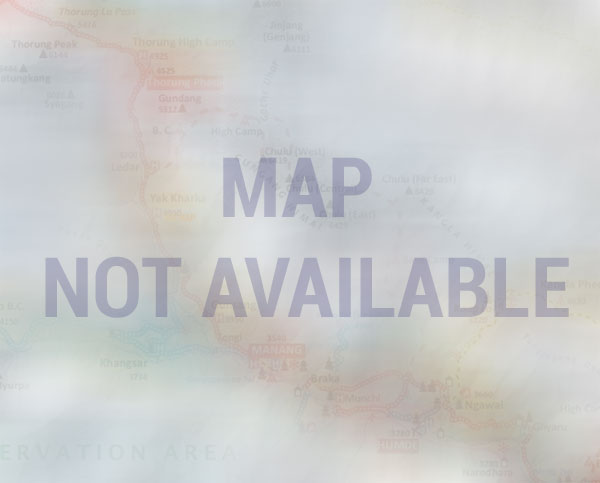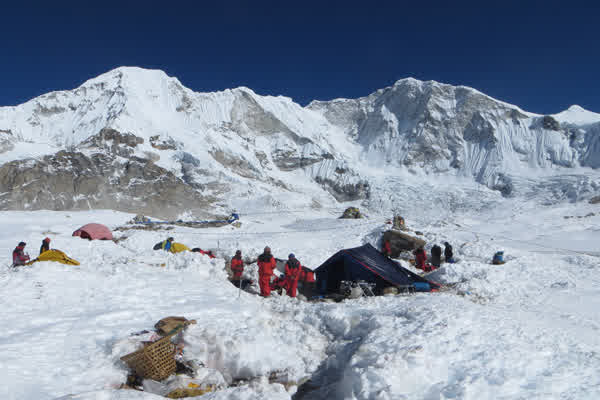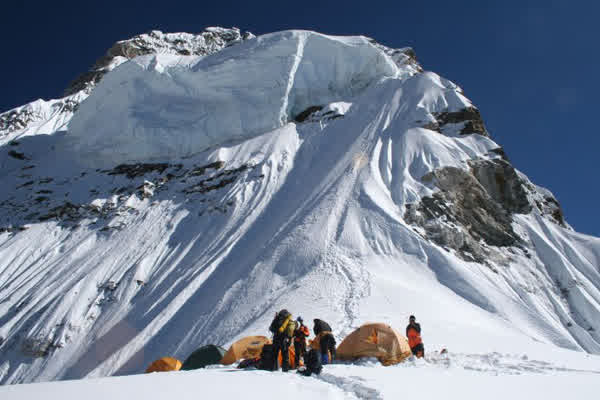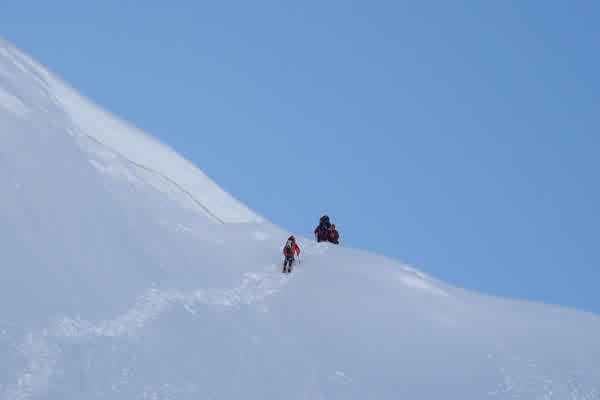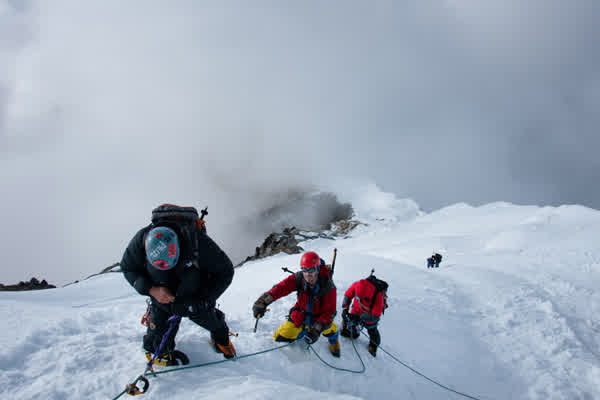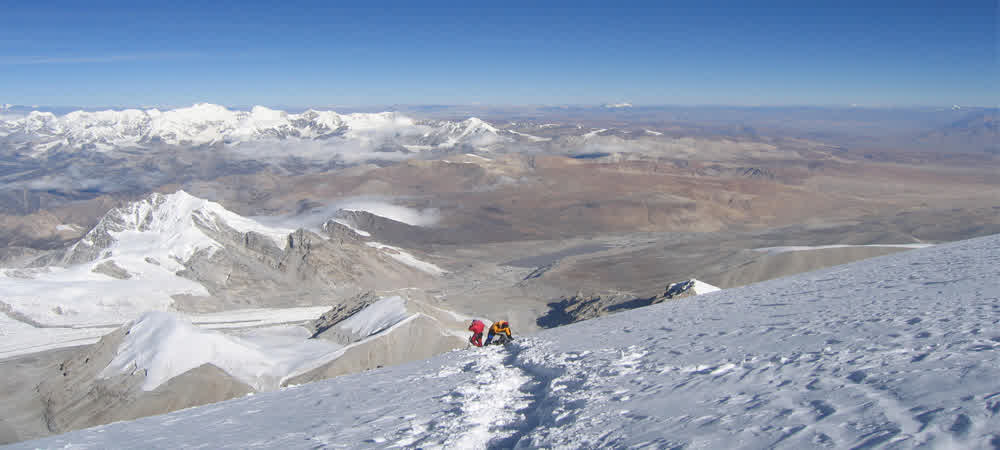
- Overview
- Itinerary
- Price & Dates
- Useful Info
- F.A.Q.
- Gallery
Facts of this Trip
Cho oyu Expedition
Mt. Cho Oyu, the world's sixth highest mountain at 8,201m, is located west of Mt. Everest along the Nepali-Tibetan border. A straightforward climb and not technically demanding, an excellent mountain for climbers wanting to scale their first 8,000m peak without taking much risk.Our Cho oyu expedition itinerary that begins by driving into Tibet through Kordari, crossing the Himalaya through gorges of Bhote Koshi. The drive is simply awesome!! And full of excitement, we'll arrive on the other side of Himalaya from Kathmandu to Nyalam on the first day. We'll spend our nights in Nyalam relaxing and hiking the hills for acclimatizing. From Nyalam, we begin our overland travel across the plateau and high passes. We'll continue on to Tingri (4,300m) through fantastic plateau scenery with a stop at the Buddhist monastery Milrepa built around a sacred cave. Along the last few miles into Tingri, views of Makalu, Everest, and Cho Oyu remind us why we're here. Tingri itself is made up of old-style mud and stone buildings with an army base at its rear. Tibetan nomads use the town as a base during their stay in this desolate part of the plateau. After arrival at Chinese Base Camp, we'll rest, acclimatize and make the necessary climb preparations before making our ascent to advanced base camp at 5,700m. We'll cross through steep moraines to establish Camp 1 at 6,400m, which should take around 4 - 6 hours depending on weather conditions and how we're feeling. We'll traverse a ridge and ascend a 50m headwall to Camp 2 at 7,000m - a hard day taking 6 - 7 hours. Our strong Sherpas will fix all the ropes as required. We'll establish Camp 3 at 7,500m on the northwest face, and the following day, set up for the summit. Depending on fitness, we'll be moving up and down the mountain several times, acclimatizing and stocking the higher camps. It will require an extra push to reach the true summit Cho oyu peak on the far end of the high snowfield. Summit day, though long and arduous, will be well worth it when the highest peaks in the world are in view.
Expedition Highlights:
Experience 6th highest peak, and technically easy but physiologically challenging climb
Stunning views from the summit on perfectly lined-up Everest, Lhotse, and Makalu
Accessible 8000m climb Himalayan climb and test of skills and physiology for Everest attempt
Experience your first 8000m climb on the relatively safe route
Interesting experience of Tibetan culture in Tingri
Test for mountaineering isolation and psychological endurance
Fitness
To participate in this expedition you must be a very fit and active winter-walker-climber in good health. Prior to joining our group, please see your doctor and obtain the necessary permission and advice, as well as medications for travel in extremes of altitude, and also for exotic locales.
Experience
Previous mountaineering experience is required to at least 6000m. You will also need to be very determined. Cho Oyu is a non-technical peak with the possibility of a ski descent for VERY strong skiers. Ski touring in the area near ABC is also possible (and a fun way to acclimatize).To succeed you will need to be extremely fit and have a high level of endurance. You don't need to be fast but you need to be steady and strong. Mental toughness plays a large role as does the ability to relax and let your body acclimatize.
Autumn season (Sept-Nov): being the best season for climbing Mt. Cho-Oyu, offers excellent weather and tantalizing mountain views, and also the best season for peak climbing.
Summer months (June-September): of the year which coincides with monsoon begins in mid-June and drains in mid-September making travel wet and warm. The mountain views may not be at their best as rain clouds and haze overhang the mountains occasionally obscuring the enchanting views. These times are blessed for the keen botanist as the higher valleys and meadows blossom with flowers and lush vegetation.
Spring season (March-May): is the expedition season and the best time for climbing the high peaks. It is mildly warm at lower elevations but occasional haze mars the beautiful view of mountains. At higher elevations over 4,000 meters, the mountain views are excellent and the temperature is quite moderate even at night. Winter season (December-February) is noted for cold weather with occasional snowfall at higher elevations. Again, excellent views are common. These months are popular and ideal for trekking for those who are well equipped or who remain at lower elevations below 3,000 meters. Most of the hotel owners will come to the lower altitude cities like Kathmandu and Pokhara.
Trip Itinerary
Arrival at Kathmandu
Briefing, sightseeing, preparation for expedition
Final Preparation for expedition
Drive to border, after immigration; drive to Zangmu /Nyalam
Nyalam. Rest day for acclimatization
Drive to Tingri
Rest and acclimatize at Tingri
Drive to Base Camp
Base camp preparation
Trek to Advance base camp
Mt. Cho Oyu climbing period
Trek to Base camp
Drive to Nyalam/Zangmu
Cross border drive to Kathmandu
Kathmandu, free day
Final departure to home
Price & Dates
Upcoming Fixed Departure Date and Offer Price.
Trip Cost Includes
- Royalty of peak, peak registration
- Chinese visa fee for complete team members
- Chinese custom clearances at the Nepal/China border
- 05 nights hotel accommodation in Katmandu with breakfast
- Private transport from Katmandu to and from Kodari border
- land cruiser jeep transport from the China Border to and from BC (base camp)
- Chinese truck to carry expedition loads to and from BC
- Full board accommodation en-route to/from BC
- Chinese Liaison officer and interpreter
- Head Climbing guide/ Sardar to look after all the matters
- Experienced Cook & kitchen boys as per group size
- Professional and Experienced High Altitude Climbing Sherpa (One Sherpa between 2 clients)
- 3 Meals per day at BC & ABC with hot drinks
- Best quality high altitude tents for the higher camps
- Imported High foods for higher camps above ABC (advance base camp)
- Best quality tent at BC and ABC either single or twin sharing
- All necessary kitchen equipment’s
- Dinning tent with gas heater at BC
- Comfortable toilet and shower tent sat BC
- Yaks for BC-ABC-BC to carry loads
- Necessary climbing hardware gears with fixed ropes, snow bars etc.
- EPI gas with burners to use above ABC for cooking purpose
- Oxygen with mask regulator set for medical purpose at BC/ABC
- Satellite phone for emergency purpose (personal call $ 4 per minute)
- Generator/Solar panel with accessories for recharging and power supply purpose at BC
- Storage and communication tents
- Down jackets/sleeping bags for BC/ABC purpose
- Gamow/PAC bag at BC/ABC for medical purpose
- Insurance of all local team members
- All airport/hotel transfers.
- Celebration meal & pre-briefing.
ADDITIONAL SERVICES IF YOU REQUIRED:
- ABC Support trekkers : US $ 5500 per person
- Extra climbing Sherpa : US $ 5000per Sherpa(Includes Sherpa’s daily wages, equipment allowances, insurance, load ferry bonus to the high camps, visa fee, local transportation, food & accommodation and of course TIBET ENTRANCE FEE US$ 2800/- per climbing Sherpa etc.)
- POISK 4 liter Oxygen : US $ 530 per tube
- Poisk 4 litter Re fill Oxygen: US$ 330 per
- tubeMask set : US $ 590 (purchase) USD 260 per set
- Personal satellite phone : US $ 500 (royalty only)
- Lhasa extension : US $ 950 per person (including 3 night full board accommodation, KTM – Lhasa airfare, 3 days tour with necessary entrance fees etc)
Trip Cost Exclude
- Personal travel Insurance
- Nepal visa/re-entry visa fees
- Major meals in Kathmandu.
- Personal climbing gears.
- Personal natures expenses
- Cost of emergency evacuation
- Summit bonus & Tips to the local staff
Useful Info
- The maximum total duration of expedition is 40 days, no refund is made for any unused services
- Summit bonus minimum is USD 500 for one climbing Sherpa
- If you prefer to climb with personal Sherpa support, US$ 2500 is the additional cost.
- All the emergency evacuation will be made by Jeep, there is no helicopter service in Tibet, In case of emergency evacuation by jeep from the base camp to nearest hospital or to border, Clients is responsible to pay directly to Liaison officer at base camp for the service of jeep. Each jeep cost $ 750
- The group should enter and exit from the border at same time, in case of early departure from base camp due to personal reason, emergency evacuation or any other reason, the cost of jeep should be paid by client himself or herself.
- Expedition member’s personal baggage allowed is maximum of 40 KG either from BC to ABC or ABC to BC; if the personal baggage is excess than 40 KGS then extra amount is levied.
- There is no individual visa for the Tourist group. We will obtain a group visa for the entire team. If any expedition member needs to be early departure from base camp due any reason then he/she should pay Chinese currency 165/$35 at the Chinese immigration atthe order to cancel his/her name from the visa list and US$ 150/- will be charged for transportation from border to Kathmandu.
Frequently Asked Questions.
Media Gallery
Please click on small photos to have larger view.

